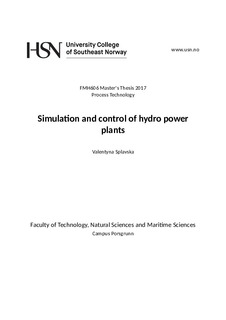| dc.description.abstract | Sustainable energy development implies meeting the energy needs of the future without jeopardizing the life quality of the planet. To achieve these goals is possible by gradually replacement in energy production profile of traditional energy sources by renewable until technically reasonable level. Hydropower is an undeniable leader among renewable energy sources and an important technological tool for implementation of Europe’s ambitious climate and energy goals. This is proven by latest official reports and investigations. Inclusion into the grid of variable in time hydropower energy sources can cause distrubances. This impacts significantly to the quality of electricity and grid balancing. For generation profile prediction and control purpose, modeling of the hydropower systems is used. Since hydropower systems are principally similar and match well object-oriented modeling capabilities.
The objective of this thesis is to develop mechanistic model of the hydropower system and to validate it. For this purpose, the mechanistic model based on the Euler equations was developed and tested by application to the case studies with different components configuration. For simplicity, the compressibility of water and elasticity of pipe walls were neglected, since the main aim is to compare a turbine model based on the Euler equations vs. a table look-up model. The influence of surge tanks on the transients of the system was illustrated.
The developed model is not suitable for analysis of cavitation, because compressibility neglecting and filtering out of some pressure transients by elasticity in water/pipes. The research contributes in refining a case study for hydropower systems, and in emphasizing the usefulness of mechanistic turbine models. The results of model simulation were validated by comparison with ”hill charts” model for relevant components configuration and empirical model consisting of look-up tables based on the turbine geometry obtained by using Alab software. | nb_NO |
